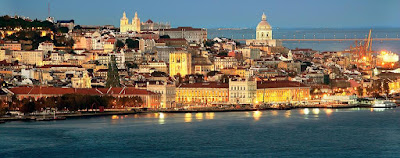We have received a
postcard from one of the most charming cities in the world, Lisbon!
 |
| Lisbon |
WHERE IS LISBON?
 |
| Location of Lisbon in Portugal |
Lisbon is the capital
and the largest city of Portugal, with a population of more than 552,000 in an
area of 100.05 square km. It is continental Europe's westernmost capital city
and the only one along the Atlantic coast. Lisbon lies in the western Iberian
Peninsula on the Atlantic Ocean and the River Tagus.
LISBON IS FAMOUS FOR…
… its steep hills and
narrow streets that, as Ángela tells us in her postcard are full of beautiful
tiled façades, elegant cafés and lovely shops where we can buy traditional
Portuguese products, including the so-called pasteis de nata, Portuguese pottery and a careful selection of food and drink delicacies.
 |
| A street in Lisbon |
 |
| Pasteis de nata |
…its trams.
 |
| Lisbon tram |
Introduced
in the 19th century, the trams were originally imported from the USA, and
called the americanos. The earliest
trams can still be seen in the Museu da Carris (the Public Transport Museum).
Other than on the modern Line 15, the Lisbon tramway system still employs small
(four wheel) vehicles of a design dating from the early twentieth century.
These distinctive yellow trams are one of the tourist icons of modern Lisbon,
and their size is well suited to the steep hills and narrow streets of the
central city.
… Fado, a form of music
characterized by mournful tunes and lyrics, often about the sea or the life of
the poor, and infused with a sentiment of resignation, fatefulness and
melancholia.
 |
| Fado |
Fado appeared during the early 19th century in Lisbon, and is
believed to have its origins in the port districts like Alfama, Mouraria and
Bairro Alto. Portuguese fadista, Amália Rodrigues, also known as the
"Rainha do Fado" ("Queen of Fado") was most influential in
popularizing fado worldwide.
 |
| Amália Rodrigues |
Fado performances today may be accompanied by a
string quartet or a full orchestra.
PLACES TO VISIT
Baixa
 |
| Rúa Augusta. Lisbon |
The heart of the city
is the Baixa or city centre; the Pombaline Baixa is an elegant district,
primarily constructed after the 1755 Lisbon earthquake, taking its name from
its benefactor, 1st Marquess of Pombal, Sebastião José de Carvalho e Melo, who
was the minister of Joseph I of Portugal (1750–1777) and a key figure during
the Portuguese Enlightenment.
Known in Portuguese as O elevador de Santa Justa, this lift is
a major attraction in the civil parish of Santa Justa, in the historical city.
Situated at the end of Rua de Santa Justa, it connects the lower streets of the
Baixa with the higher Largo do Carmo (Carmo Square).
Literally the upper
quarter in Portuguese, it is an area of central Lisbon that functions as a
residential, shopping and entertainment district; it is the centre of the
Portuguese capital's nightlife, attracting hipster youth and members of various
music subcultures.
The oldest district of Lisbon, it
spreads down the southern slope from the Castle of São
Jorge to the River Tagus. Its name, derived from the Arabic Al-hamma, means fountains or baths. During the Islamic invasion
of Iberia, the Alfama constituted the largest part of the
city, extending west to the Baixa neighbourhood. Increasingly, the Alfama
became inhabited by fishermen and the poor: its fame as a poor neighbourhood
continues to this day.
Belém is famous as the place from which
many of the great Portuguese explorers set off on their voyages of discovery.
In particular, it is the place from which Vasco da Gama departed for India in
1497 and Pedro Álvares Cabral departed for Brazil in 1499. It is also a former
royal residence and features the 17th–18th century Belém Palace, a former royal
residence now occupied by the President of Portugal, and the Ajuda Palace,
begun in 1802 but never completed.
Perhaps Belém's most famous feature is
its tower, Torre de Belém, whose image is much used by Lisbon's tourist board.
The tower was built as a fortified lighthouse late in the reign of Dom Manuel l
(1515–1520) to guard the entrance to the port. It stood on a little island in
right side of the Tagus, surrounded by water.
Belém's other major historical
building is the Mosteiro dos Jerónimos (Jerónimos Monastery), which the Torre
de Belém was built partly to defend.
 |
| Belem Tower Fort |
 |
| Mosteiro dos Jeronimos |
If you want to get a taste of Lisbon's
charm, watch this video!




No comments:
Post a Comment